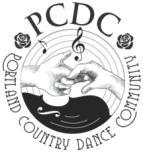First-Time Dancers
What is contra dancing?
Contra is folk dancing generally done to live music with a caller. It shares some similarities with English Country dancing, but is more energetic, and with Square dancing, but we think it’s more fun. Our dances focus on the community, not individual couples. Dancers pick a new partner before each dance and hop in line together. The caller will slowly walk through a sequence of moves while everyone in the lines follows along. Once we’ve learned the dance, the band will start and the caller will guide us through those same moves again and again. You’ll stay with the same partner for the whole dance, but your neighbors in line will change with each repetition. By the end of the dance, you’ve danced with dozens of folks!
It’s easy to learn but never boring. There are no special steps, we walk around in patterns to the beat of the music. There are thousands of different dances, but they all use the same set of basic moves. Soon you’ll appreciate the flow of the moves, the energy of the music, and the fun of it all. Sometimes it feels like we’re creating a rollercoaster for ourselves! We have great bands who play traditional and modern Celtic, English, French Canadian, Scandinavian, and old timey music, as well as whatever genre the band loves. You can’t sit still to this great music–you just have to get up and dance!
If you’re more of a visual person, we have lots of videos from our home dance hall. Here’s a good one:
You and your partner will each be dancing a different role. If you’ve watched other contra videos, you may have noticed that callers use various terms to refer to these roles. We use non-gendered terms such as “Larks” to refer to the person on the Left after a partner swing and “Robins” to refer to the person on the Right. At other venues, “Ladies” and “Gents” or similar may be used, but the practice is dying off. This is a remnant from the 20th century and has nothing to do with dancer gender.
How can I prepare?
Find an evening you can attend and show up before the 7 pm newcomers’ lesson starts. Almost all contra dances in Portland start the evening with a newcomers’ lesson. It’s okay if you show up a little late, but you’ll be much better off if you’re present for the whole lesson. There are always experienced dancers ready to join in and help so this is also a good time to meet people.
You do not need to bring anyone with you. If you do, we suggest not dancing your first few dances with them unless they’re already experienced. You’ll learn significantly faster if you have dance partners that can teach while you’re moving.
Ideally you’ll be clean and scentless – even your conditioner/soap/deodorant. We encounter dozens of people in close proximity while dancing, so not triggering migraines and allergies is important. Dancers that sweat a bunch tend to bring a few extra shirts to swap into (and extra masks whenever COVID protocols are in effect).
We’d love it if you read our Contradance Etiquette before coming. We keep this updated and it represents the community we strive to foster.
What should I wear? Bring?
Check PCDC’s COVID policy. Currently, proof of vaccinations and masks are not required, but we encourage both.
Wear comfortable clothing that will stay on while spinning. Tee shirts are a popular choice as are twirly skirts, regardless of gender. Shimmy around and do a spin before heading out the door. Is your clothing still comfortable?
For your feet, wear something you can maneuver in. Can you stand on your tiptoes comfortably? Stiff boots and hiking shoes are generally not going to work well. Dance shoes are great. Some people even go barefoot.
If your hair is long, consider bringing something to keep it out of the way. If it’s long enough to hit other people while spinning, please do tie it up.
Bring a water bottle! There will be a line for the drinking fountain.
Who do I dance with?
Hopefully you meet a few dance partners during the lesson. Ask them to dance! You can ask anyone at all. Perhaps you danced with a neighbor in line and admired their swing. Ask them too! Really, ask anyone at all.
The dances start off fairly simple and progress in difficulty through the evening. There will be a waltz at the end of each half and, while we don’t have a lesson for that, there is a room full of dancers who would be glad to teach you.
We do a couple’s dance, usually the hambo, to begin the second half. If you already know it, grab a partner and join! If you don’t, enjoy the music and keep an eye on event flyers to see when it will be taught.
Injuries & Disabilities
Not everyone can spin around the room at lightning speed. Dancers will often put tape or otherwise signal that they have an injury or area to avoid. If you see an “X” in tape across someone’s shoulder, wait for them to take the lead when going in for a swing. If someone’s arm is in a sling, you can still do the same moves, but don’t make contact. So long as your bodies end up where they’re supposed to be, you’ve done it right! Even if they don’t, remember – it’s just a dance.
Now what?
Check out the general information about our Portland Contra Dance series.
